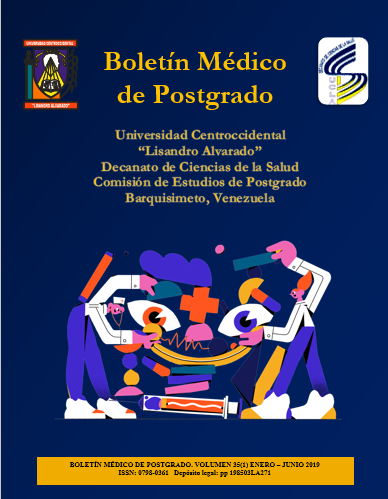Risk factors of Gestational Trofoblastic Disease. Hospital Central Universitario Dr. Antonio María Pineda
Keywords:
gestational trophoblastic disease, risk factors, abortion, intrauterine devicesAbstract
Gestational Trophoblastic Disease (TSG) is a pathology of the first half of pregnancy characterized by a hydropic degeneration of the chorionic villi that spans the placenta and the rest of the ovular complex; it is usually benign, but it can become malignant and spread to other tissues. A descriptive transversal study with retrospective review of medical charts was performed in order to determine the risk factors for TSG of patients evaluated at the Servicio de Emergencia Gineco-Obstétrica of the Hospital Dr. Antonio Maria Pineda during the January-August 2018 period. Fifty-five medical charts were reviewed. Results show that TSG was more common in women < 28 years old that lived in urban areas, which had several pregnancies, with no prior history of spontaneous abortion, molar pregnancy, use of intrauterine devices or prolonged use of contraceptive pills. In conclusion, a follow-up of young pregnant women is necessary in order to have an on time diagnosis of this disease as well as promote measures that guarantee the patients’ health as well as her life.
Downloads
References
2. Durón G, Bolaños M. Enfermedad Trofoblástica Gestacional. Medicina Legal de Costa Rica 2018; 35(1).
3. Moncayo P. Incidencia y factores de riesgo asociados a la enfermedad trofoblástica gestacional en los años 2013 – 2016 en el Hospital Teodoro Maldonado Carbo. (Sitio de Internet). (Trabajo de Grado no publicado). Universidad de Guayaquil. Disponible: http://repositorio.ucsg.edu.ec/. Consulta: febrero 22, 2018; 2017.
4. Ucha F. Procedencia. (Sitio Web). Disponible: https://www.definicionabc. com/general/procedencia.php. Consulta: agosto 18, 2018; 2011.
5. Brito. Características Clínicas de Pacientes con Enfermedad Trofoblástica Gestacional del Hospital Central Universitario Dr. Antonio María Pineda. (Tesis de Grado no publicada). Barquisimeto. Universidad Centroccidental Lisandro Alvarado; 2017.
6. Rodríguez G. Consenso sobre Dispositivos Intrauterinos. (Sitio en Internet). Disponible http://churrucatocogineco.blogspot.com/2009/08/ateneo-consenso-diu.html. Consulta: julio 18; 2009.
7. Rodríguez C, Monsanto H., Colon J. (2016). Enfermedad trofoblástica gestacional diagnosticada en restos ovulares obtenidos de pacientes con abortos espontáneos. Revista de Obstetricia y Ginecología de Venezuela 2016; 7(2).
Published
How to Cite
Issue
Section
Las opiniones expresadas por los autores no necesariamente reflejan la postura del editor de la publicación ni de la UCLA. Se autoriza la reproducción total o parcial de los textos aquí publicados, siempre y cuando se cite la fuente completa y la dirección electrónica de esta revista. Los autores(as) tienen el derecho de utilizar sus artículos para cualquier propósito siempre y cuando se realice sin fines de lucro. Los autores(as) pueden publicar en internet o cualquier otro medio la versión final aprobada de su trabajo, luego que esta ha sido publicada en esta revista.



